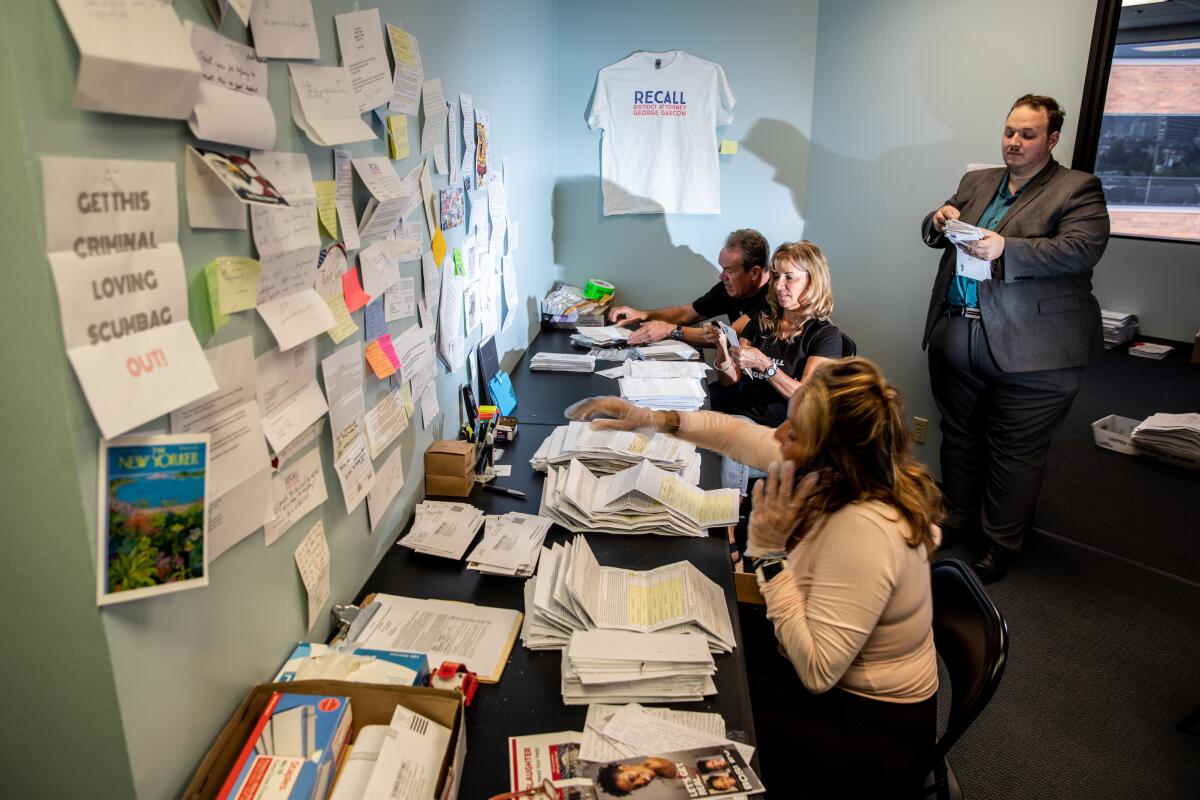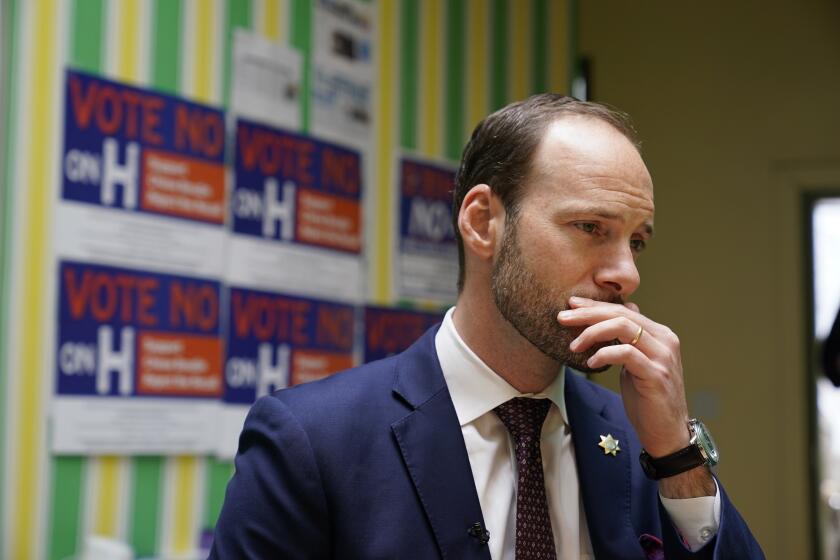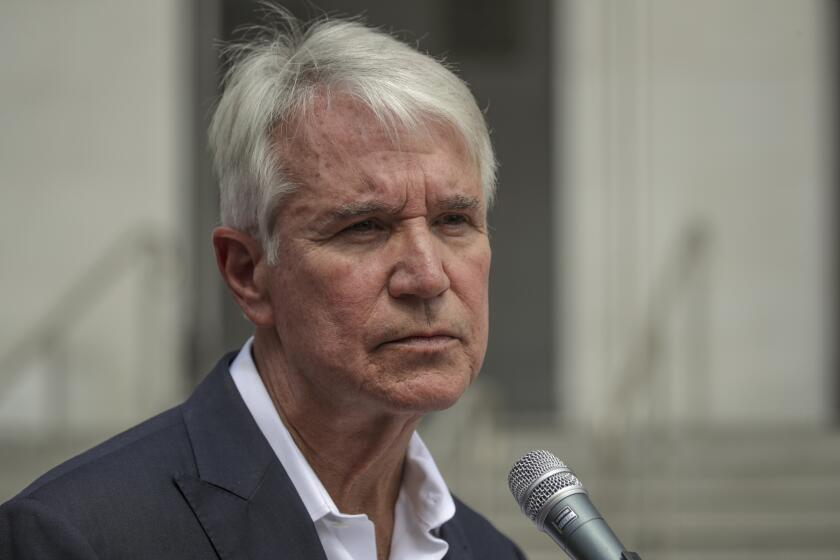Campaign to recall D.A. Gascón has submitted thousands of signatures. What happens now?

- Share via
The campaign trying to force Los Angeles County Dist. Atty. George Gascón from office submitted more than 715,000 signatures in support of the recall to the L.A. County registrar on Wednesday.
Although that total exceeded a previous attempt to recall Gascón that failed last year and might be enough to put the issue to voters, opponents of Gascón’s reform-minded agenda can’t celebrate just yet.
Committee seeking to recall L.A. County Dist. Atty. George Gascón says it won’t meet October petition deadline, but will try again later this year.
It remains to be seen whether the referendum on Gascón will qualify for the ballot. And, if it does, the campaign then faces a much tougher challenge: convincing more than 50% of voters in a recall race that Gascón should go.
So what comes next?
Recall Qualification
Before voters can decide whether to recall an elected official from office, a campaign must collect signatures from a number of supporters equal to 10% of registered voters in the election the target of the recall won.
There were 5,668,570 registered voters in L.A. County in November 2020, when Gascón ousted two-term incumbent Jackie Lacey to become top prosecutor, according to the registrar’s office, meaning the campaign to oust him needed at least 566,857 valid signatures.
Although the recall campaign said it turned in about 717,000 signatures Wednesday, some of those will be disqualified during a verification process conducted by the county registrar.
Joshua Spivak, an expert on recall elections, has said as many as 20% of the signatures could be tossed, citing similar disqualification rates in efforts to recall San Francisco Dist. Atty. Chesa Boudin and Gov. Gavin Newsom from office.
Progressive San Francisco Dist. Atty. Chesa Boudin is recalled after a bitter and pricey campaign amid rising fears over crime and homelessness.
Signatures are invalidated for a number of reasons, including if a person isn’t registered to vote in L.A. County, the address at which a person is registered to vote doesn’t match the one given on the recall petition, or if a signature doesn’t match the one the registrar has on file.
The registrar’s office now has 30 days to verify the signatures submitted by the Gascón recall campaign.
Michael Sanchez, a spokesman for the registrar, said the office would finalize its methodology for validating signatures after receiving the petition forms the campaign used to collect signatures. And although the recall campaign issued a statement last month demanding the registrar verify the signatures on every petition form, Sanchez noted the state’s election rules permit the office to examine just a random sample of the forms.
What happens if the recall fails to qualify?
A second failed attempt to get a Gascón recall on the ballot would likely mark the end of the effort to oust him prematurely, according to Tim Lineberger, a spokesman for the recall campaign. He said if they come up short this time, organizers would instead turn their efforts to defeating Gascón when he is up for reelection in 2024.
What happens if the recall qualifies?
The soonest a recall election could take place is Nov. 8, in a general election that includes runoff races for Los Angeles city mayor and county sheriff, as well as national midterms, Sanchez said. The latest a special election could be held is January 2023, he said.
For the recall to succeed, more than 50% of voters would need to vote to remove Gascón from office. And in Los Angeles County, voters must also choose who should replace elected officials who are recalled.
Political observers generally agree this type of recall gives an advantage to Gascón, who will be able to point out the flaws of those seeking to replace him to voters. The presence of Larry Elder on the ballot in the 2021 attempt to recall Gov. Gavin Newsom, for example, was widely viewed as a boon for Newsom, who ultimately parried the recall by a huge margin.
Energized by the ouster of San Francisco’s D.A.,opponents of George Gascón in Los Angeles County are close to putting his recall on the ballot.
Several people are believed to be considering runs to replace Gascón.
Among them are Deputy Dist. Attys. John McKinney and Jonathan Hatami, both veteran prosecutors who have routinely attacked Gascón’s policies and his handling of a number of controversial cases.
Calling Gascón a failure, McKinney said Tuesday he intends to “run a strong campaign to restore public safety and proportional justice across Los Angeles” if the recall qualifies for the ballot. Hatami started a political action committee earlier this year to raise funds for the recall effort.
Steve Cooley, who preceded Lacey as district attorney and was the last Republican to hold the office, is a co-chair of the recall campaign and, so far, is the most well-known name in the field of potential challengers. But Cooley has also faced criticism from within the recall movement after The Times revealed he had done consulting work for a TV personality seeking to avoid registering as a sex offender.
Cooley and Hatami declined to confirm they were considering a run if the recall qualifies.
More to Read
Sign up for Essential California
The most important California stories and recommendations in your inbox every morning.
You may occasionally receive promotional content from the Los Angeles Times.













